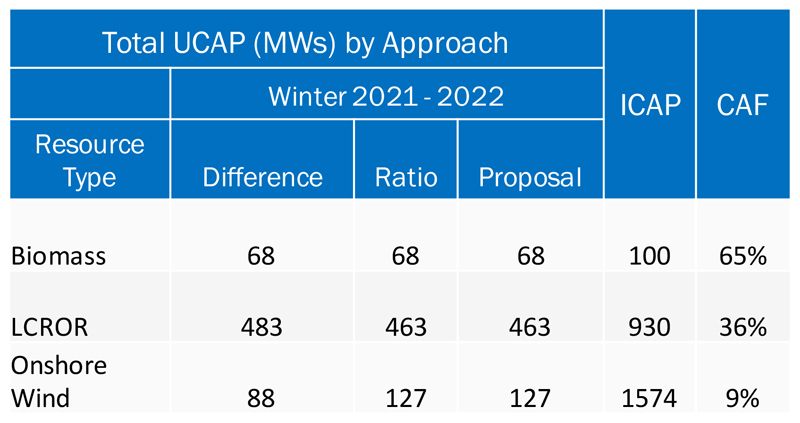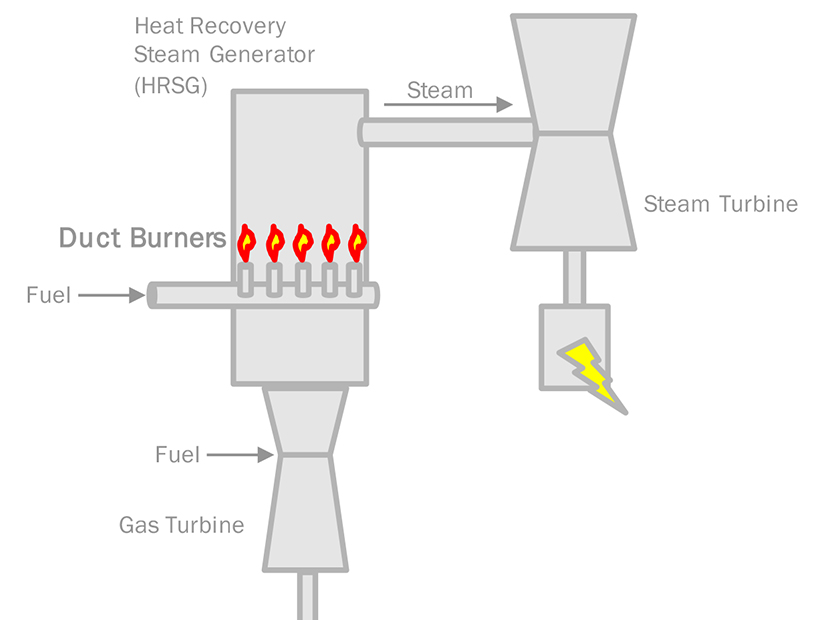Capacity Accreditation of ‘Performance-based’ Resources
Rensselaer, N.Y. — NYISO presented the Installed Capacity Working Group/Market Issues Working Group Sept. 30 with a proposed new technique for setting resource-specific derating factors for “performance-based” resources such as intermittent generation and limited control run of river. The new technique would be used in conjunction with capacity accreditation factors (CAFs) — a measure of the marginal reliability contribution of “representative” generators for each capacity accreditation resource class (CARC), a differentiation based on technology and operating characteristics.
 Comparison of difference, ratio & NYISO’s proposed UCAP methodologies | NYISO
Comparison of difference, ratio & NYISO’s proposed UCAP methodologies | NYISOThe CAFs, which reflect characteristics such as energy duration limitations and correlated unavailability due to weather or fuel supply limitations, will be used in conjunction with resource-specific derating factors that reflect the difference in a unit’s output from the modeled profile of the CARC.
The new proposal seeks to address problems with other proposed methodologies that the ISO said can result in distorted calculations of performance-based resources’ unforced capacity (UCAP).
This proposal is part of Phase 2 of the buyer side mitigation (BSM) rules that were accepted by FERC in May. (See FERC OKs NYISO Capacity Market Changes Stemming from NY Climate Law.)
NYISO’s proposed average capacity factor ratio approach can result in distorted winter UCAPs for resources that have smaller winter capacity factors than annual CAFs.
An alternative, the difference approach, can result in zero or negative UCAPs for resources with lower annual CAFs than average capacity factors in the winter.
To address the shortcomings of the two methodologies, the ISO proposed first calculating UCAPs for each performance-based resource under each approach and then assigning each resource the UCAP value that results in the closer alignment between the resource’s effective capacity value and its annual CAF.
The ISO said its testing of the proposed methodology using historical data from capability year 2021/22 concluded that the new approach removed the distorted winter UCAP values that would result from the use of either approach alone and provides reasonable values for all examined resources.
The ISO also made a presentation on a consumer impact analysis it is conducting on its capacity accreditation proposal. The analysis, which will focus on the 2030 resource mix, will consider the impacts on reliability, costs, transparency and environment and new technologies.
NYISO’s Tariq Niazi said the analysis will give stakeholders an idea of the “direction [and] magnitude” of the new methodology.
The ISO plans to present the results of the analysis at the Oct. 19 ICAPWG meeting.
Query on Transmission Nodes & TCCs
In response to a stakeholder inquiry, NYISO announced it is open to considering transmission nodes as the points of injection (POI) or points of withdrawal (POW) for future transmission congestion contracts (TCC) used to hedge congestion costs.
Transmission nodes are collections of designated load buses on which individual distributed energy resources (DER) are located, mapped, and may participate together in an aggregation.
The ISO publishes a list of valid POIs/POWs before each centralized TCC auction in Attachment E of the TCC manual. For the currently ongoing auction, the ISO lists more than 300 approved locations. The ISO also prohibits the use of certain POI/POW groupings, as detailed in Attachment F of the TCC Manual.
The ISO said it will not allow transmission nodes to be a part of a TCC in its initial deployment of the DER participation model approved by FERC and that it is not required for compliance with Order 2222. (See NYISO Discusses FERC Order 2222 Compliance.)
But it said it would consider allowing nodes as the point of injection or point of withdrawal for a TCC in the future if “presented with reasonable use cases.”
“The NYISO has not yet been presented with a productive use case for TCCs at transmission nodes,” it said.
Questions and suggestions about the proposal can be directed to Kirk Dixon (kdixon@nyiso.com).
Ramp Rates for Duct-Firing Generators
The ISO proposed to change its application of generator ramp rates (MW/min) to accommodate the 45 combined-cycle gas turbines (CCGTs) equipped with duct-firing burners, which inject additional heat to their steam cycles by burning fuel directly in the exhaust duct.
The change seeks to address a concern that the units may not be able to achieve their registered emergency response rate (ERR) when ramping through the high end of their capacity where duct burners are used. The 45 CCGTs have about 840 MWs in their duct burner regions.
The ERR, which is used for scheduling of operating reserves, is a single value that must be greater than or equal to all normal response rates (NRRs).
The new proposal would create multiple ramp rates for scheduling of 10- and 30-minute spinning reserves, reflecting the lower ramp rates seen during duct firing.
The ISO said this would be consistent with its energy scheduling rules, which use multiple ramp rates.
Testing has been performed to verify that 10- and 30-minute spinning reserves are accurately scheduled across multiple ramp rates and that the concept does not harm scheduling of other energy or regulation units.
The ISO is targeting the end of October to present a market design concept. Prototyping of the 10- and 30-minute spinning reserves participation limit will begin later in the year.
Ramp Limits on ‘Internal Controllable’ Lines
The ISO provided a justification for its proposal to limit ramping on “internal controllable” transmission lines (ICL) such as Clean Path New York (CPNY).
CPNY, a 1,300-MW high-voltage direct current line that will run 175 miles from Delaware County to Queens, is expected to be the first “internal controllable line” in the New York control area.
The NYISO says HVDC lines can ramp up and down quickly with some able to reach ramp rates greater than 1,000MW per second — a far cry from the 10-20MW per minute averaged by a typical 1,000-MW generator.
Such lines can also ramp down very quickly without a change in system generation or load. Without ramping limits, the ISO says, ICL flows can shift to parallel AC lines, potentially causing voltage to drop below operating limits or flows on AC lines to exceed limits.
The ISO said the proposed ICL ramp limits will allow operators time to adjust generator reactive and real output, switch shunt capacitors or implement phase angle regulator tap changes to keep AC lines within limits.
The ISO noted that external AC transaction scheduling interfaces and controllable lines operate under interchange ramp limits to prevent voltage problems.
It said the approach to setting limits would be similar to its implementation of the 15-minute scheduling under its coordinated transaction scheduling (CTS) with PJM, “proposing to start with conservative limits and increase ramp as operators gain experience.”
The ISO plans to discuss draft interconnection manual and deliverability tariff revisions with stakeholders through November and file tariff changes with FERC by January 2023.



